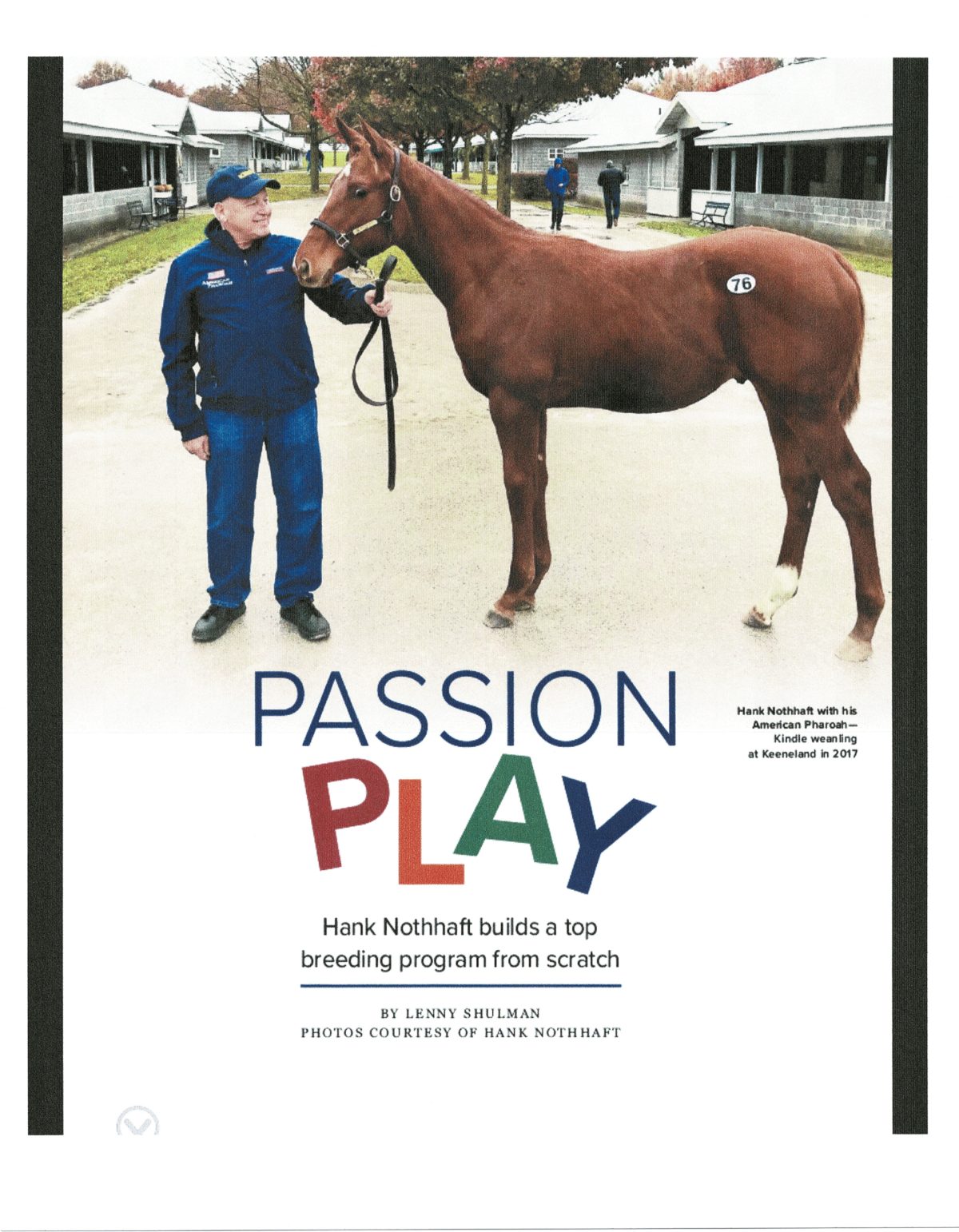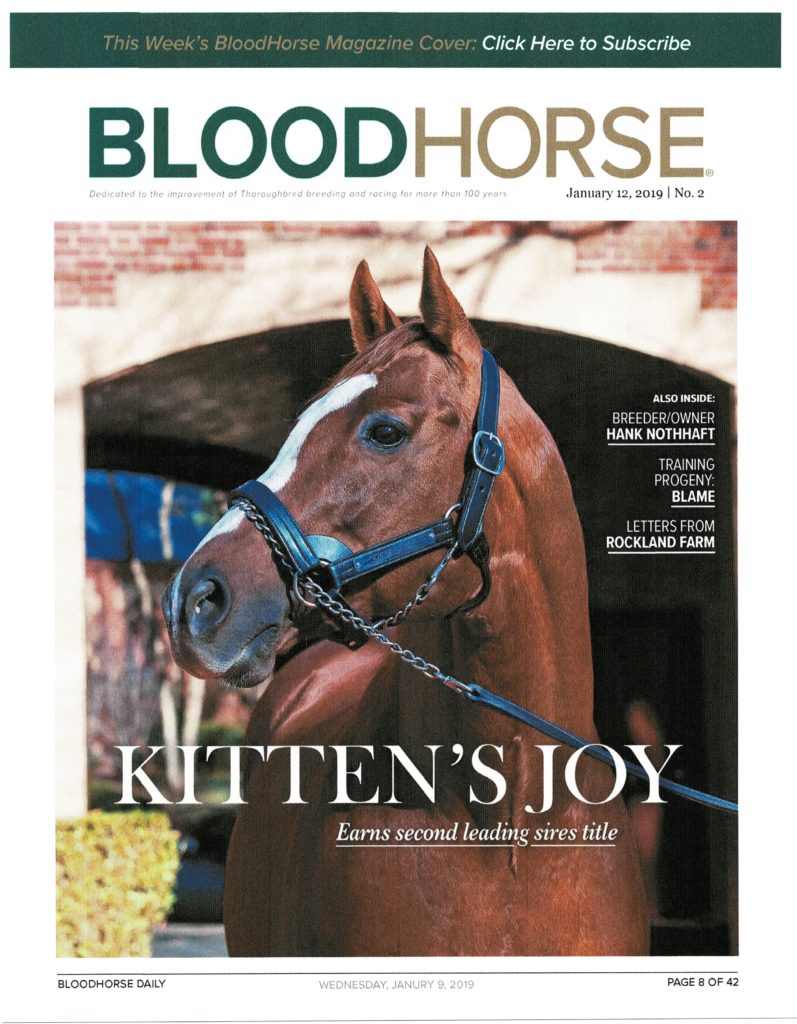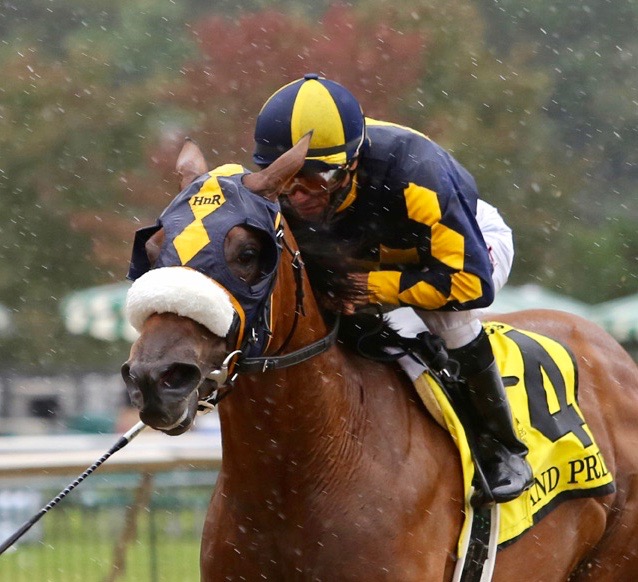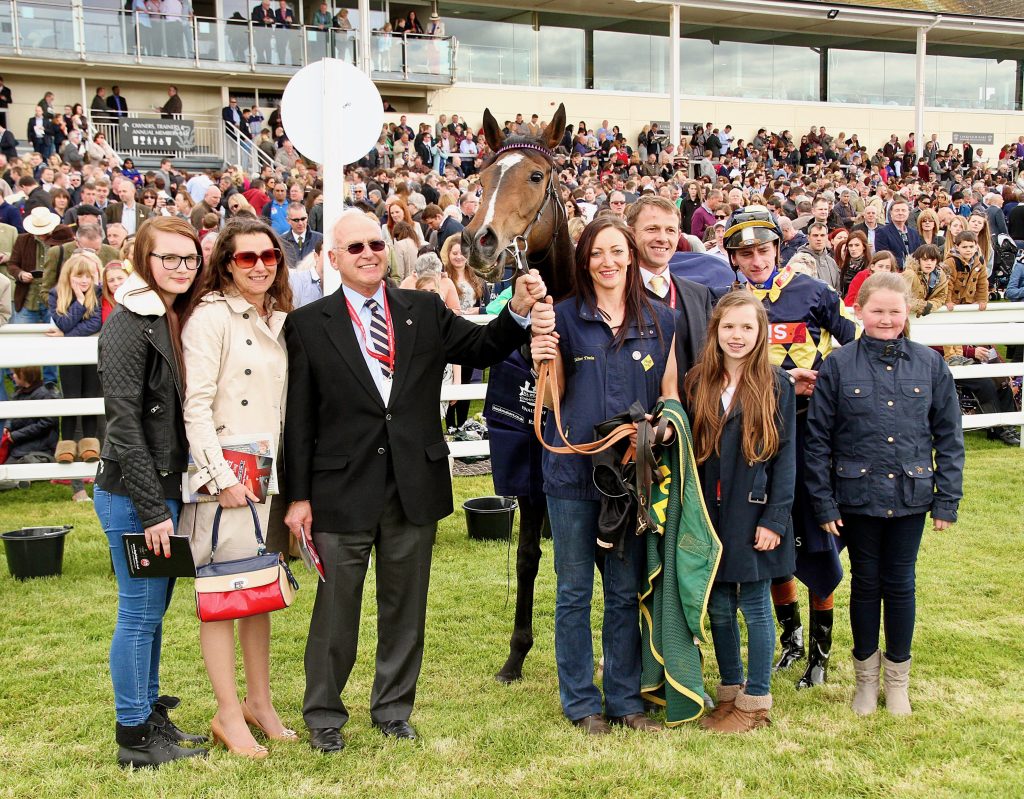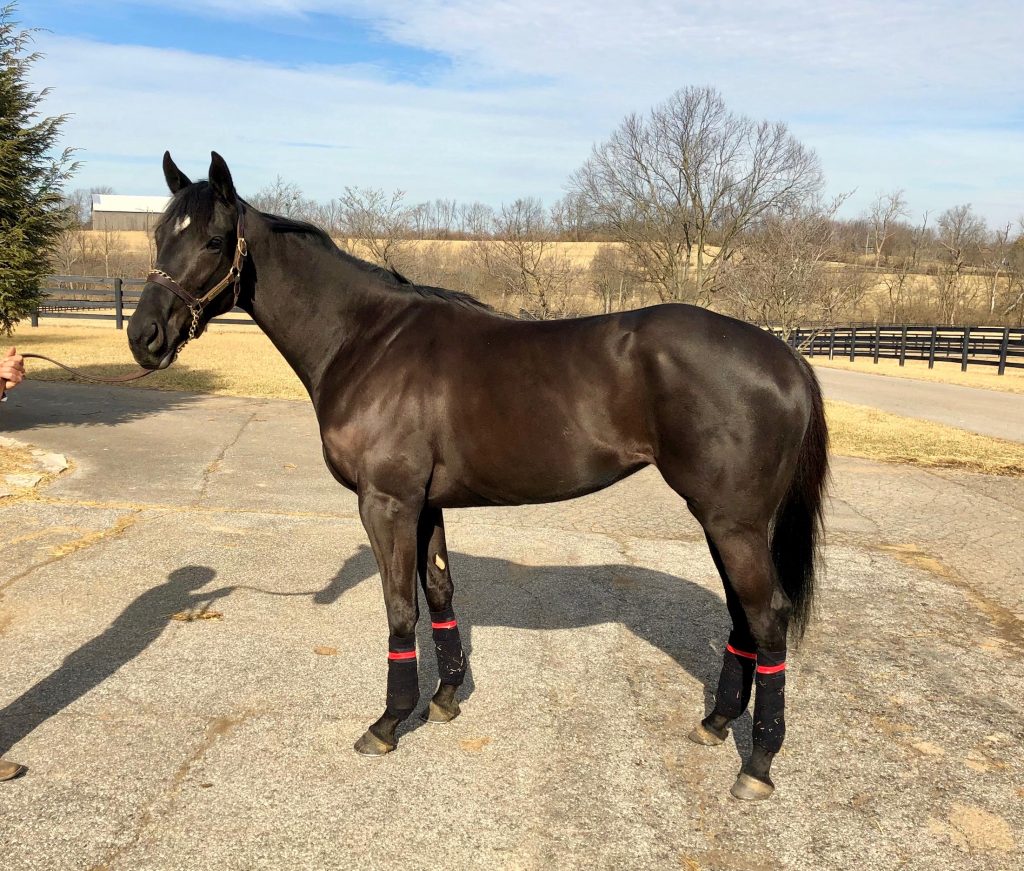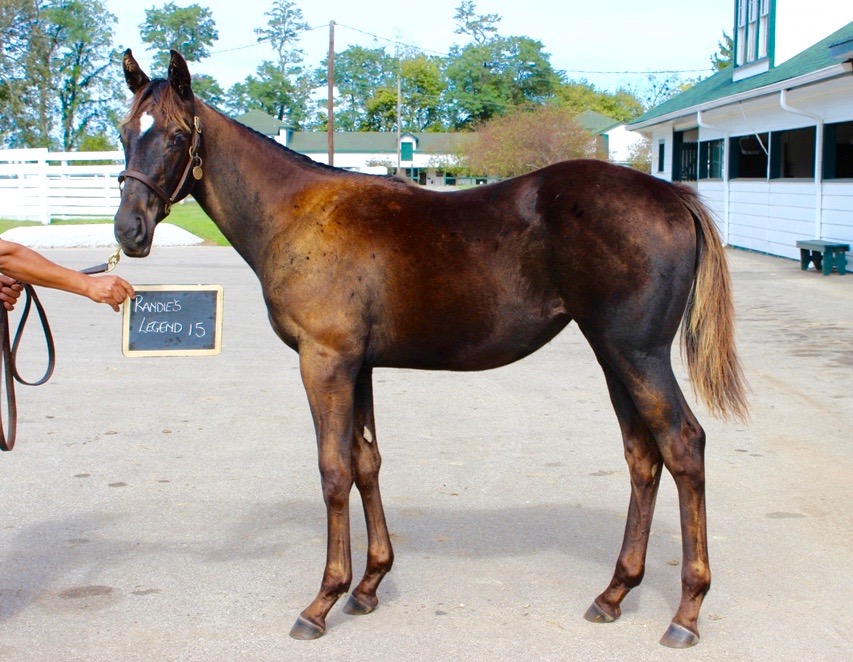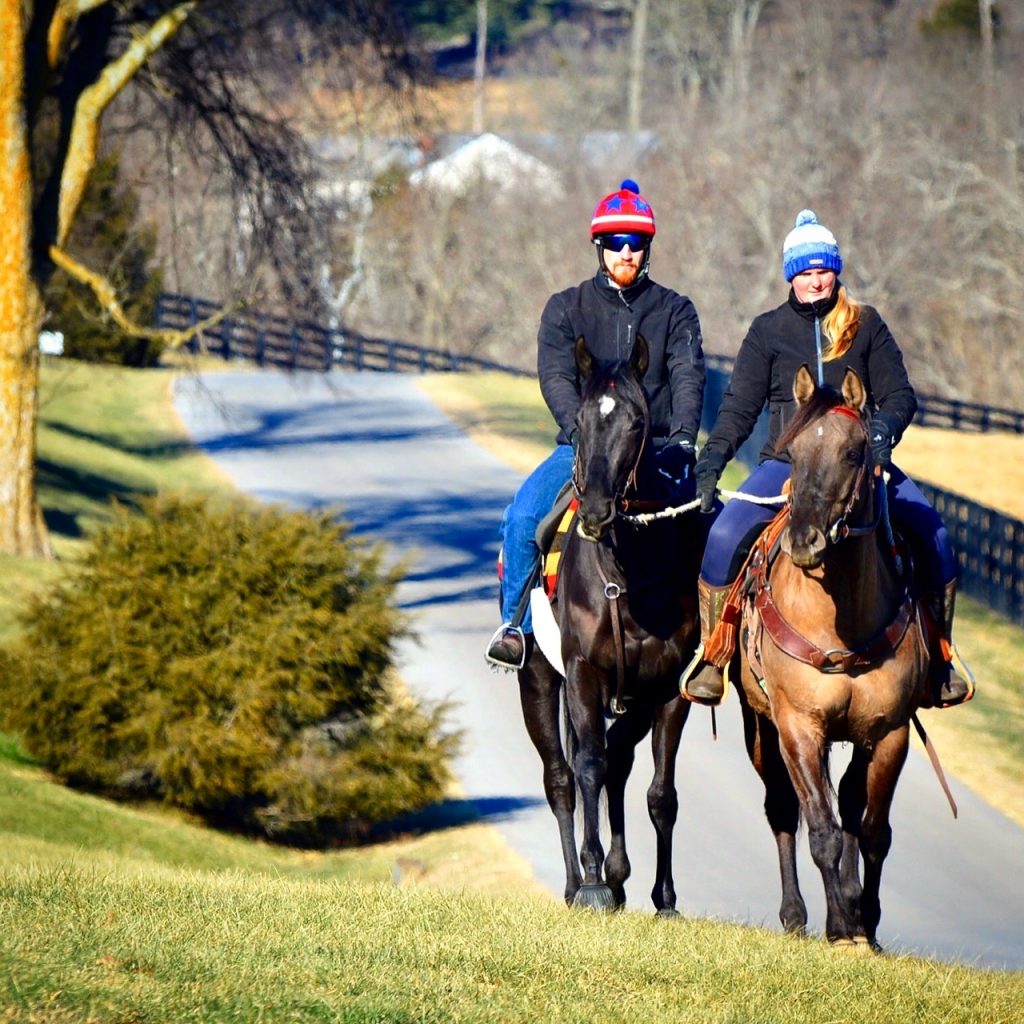Hank Nothhaft builds a top breeding program from scratch
BY LENNY SHULMAN
PHOTOS COURTESY OF HANK NOTHHAFT
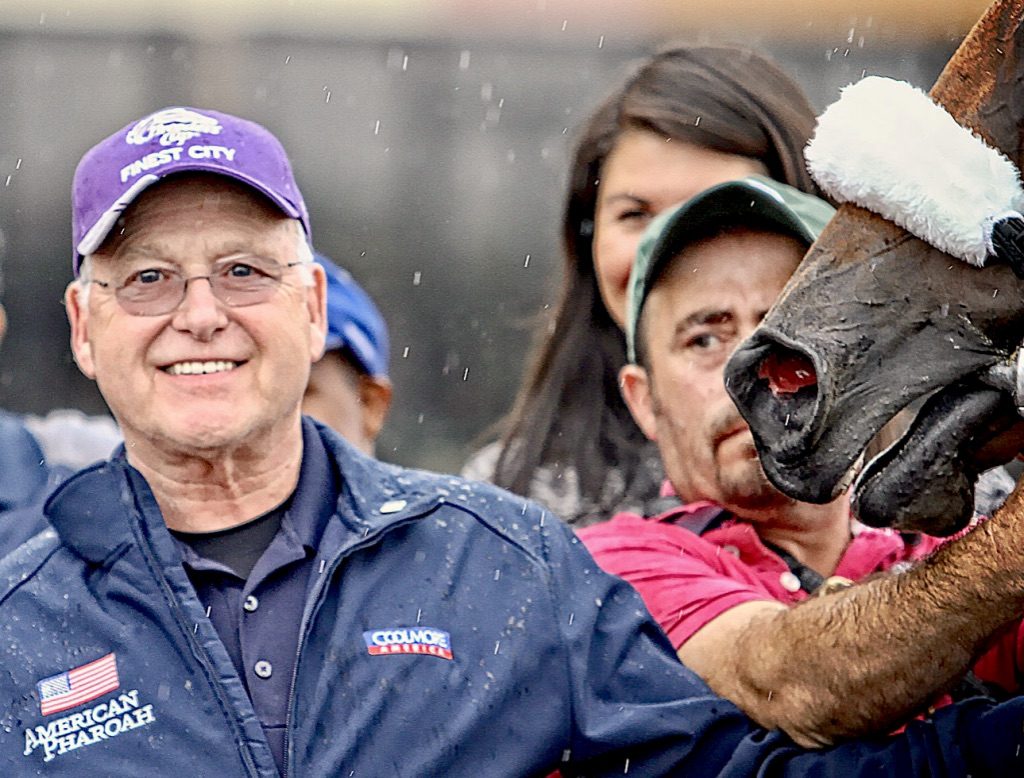
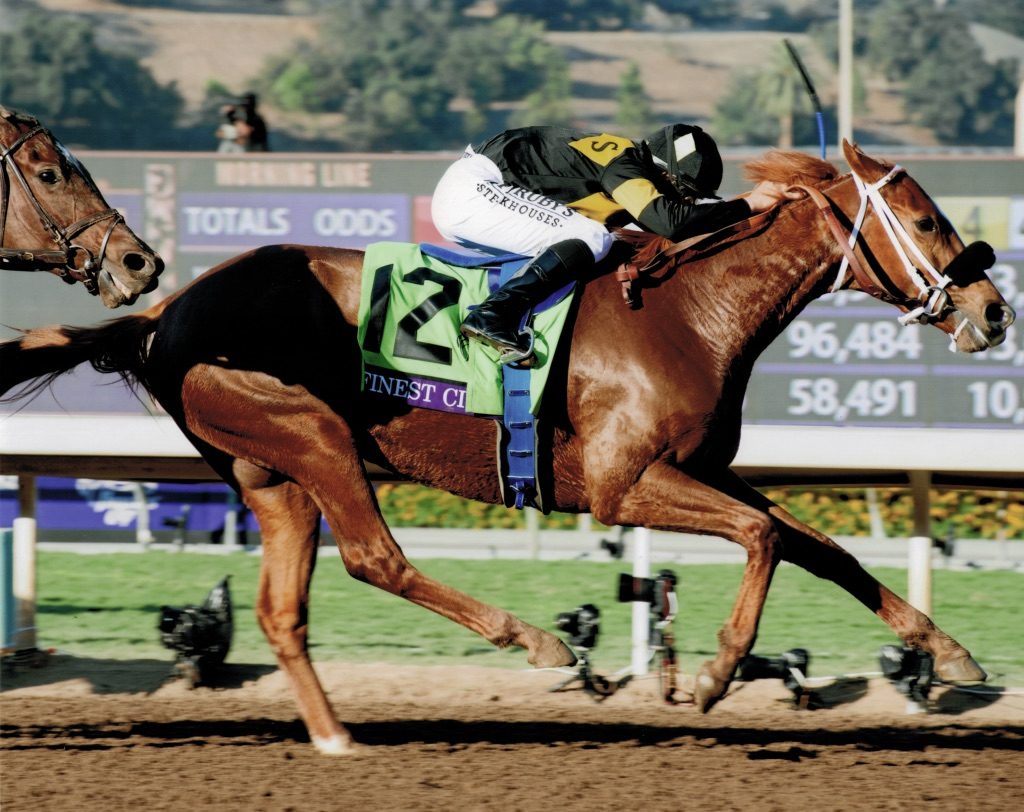
ELEVEN YEARS AGO VENTURE· TECHNOLOGY COMPANY CEO
Hank Nothhaft looked at himself in the mirror and realized that, after three decades, he was losing his passion for his work. He needed a new challenge, one that satisfied his all-encompassing, adrenaline-driven, compulsive lifestyle.
Hello Thoroughbred breeding and racing.
A decade of immersion into every thing horses has yielded significant results for the 74-year-old Nothhaft, a native of Pennsylvania who has traveled the world in both his military and civilian lives. Under HnR Nothhaft Horse Racing (the “R” coming courtesy of wife Randie) Nothhaft has bred Breeders’ Cup Champion Finest City, multiple graded stakes winner Daddy ls a Legend , and multiple stakes-winning homebred Grand Prix. He has also campaigned multiple graded stakes winner Living The Life and multiple grade 2-placed stakes winner Kindle, and has specialized in purchasing modestly priced stock that has gone on to perform on the racetrack and in the breeding shed.
There were no horses or racing in Nothhaft’s youth in Sharon, Pa ., between Erie and Youngstown, although today that area is littered with race tracks that didn’t exist decades ago. Nothhaft graduated from the United States Naval Academy and served in Vietnam , achieving his MBA in information systems technology after he exited the military. He assumed ownership of a series of tech companies, which
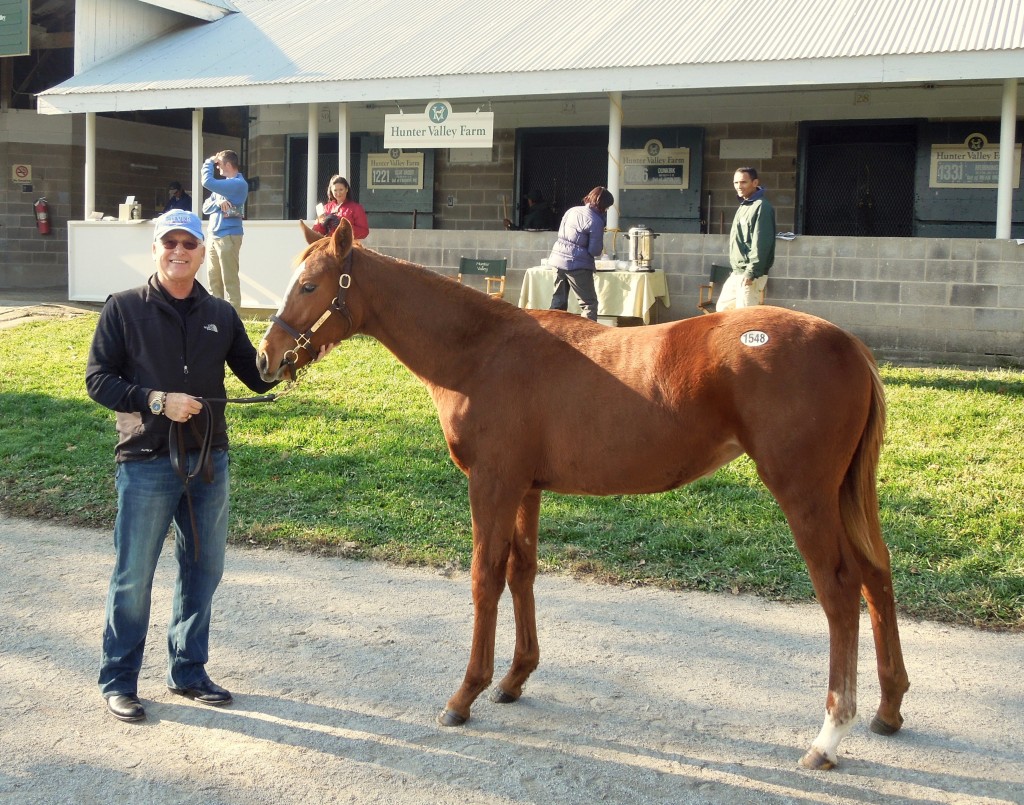
took him from Washington D.C., to Dallas, and eventually to Silicon Valley in Northern California. There, the racing bug bit him on friends-and-family outings to Bay Meadows.” We loved that place, and I developed a positive view of horse racing,” noted Nothhaft. “I was going back and forth to England quite a bit , and read all the Dick Francis novels on those trips, and began going to race tracks like Lingfield, near London, and really enjoyed it. ”
Those good feelings persuaded Nothhaft to take up the challenge of trying to survive in the horse industry, initially as an owner .
“I analyzed a bunch of different industries, and I ended up with Thorough-hred racing,” he said. ” I do look back and chuckle at my naivete in thinking I could do what has subsequently occurred. I love the competition and the immediate feedback you get on your decisions .
“What I find appealing is you can immerse yourself in the data side of it. I always had a dashboard on any company I was running and loved to throw myself into the statistics and analyze the company in as many ways as possible. So when l started looking at pedigrees and bloodlines, I thought, ‘Wow, that amount of data is perfect for an insatiable appetite like mine.’ ”
Nothhaft did his homework. He attended seminars put on by the Thoroughbred Owners of California, watched BloodHorse videos on conformation, read books, and then went out and raced some cheap claimers in Northern California, seeking to have fun, enjoy the competition, and hopefully break even. ‘The plan didn’t work well, and Nothhaft used the economic meltdown of 2009 to liquidate his stock, learn from his early mistakes, and start over again.
With the benefit of advice from Gary Mandella and Mary Knight, he began buying better Cal-breds. Chalking it up to “dumb luck,” he bought Randie’s Legend at auction for $ 43,000 in 2008 .
She would go on to produce Daddy ls a Legend. But Nothhaft turned the corner when he decided that Pennsylvania offered more opportunity than did the situation in California. He enlisted Carl McEntee to help buy bloodstock and the operation clicked. Nothhaft grabbed Kindle for $50,000, Be Envied for $37,000, Living The Life for less than $50,000, and Halljoy, who would become group stakes -placed. for $150,000 . All became valued members of his broodmare band, with Be Envied producing Finest City and Grand Prix.
“Hank came to realize that buying more-commercial broodmares was the most productive place to be, and safest to work within,” McEntee noted. “We’ve had good success and have made smart decisions on our breeding selections, which we both spend a lot of time on. ‘There’s luck involved, because this is the ‘Thoroughbred industry, and there are no certainties. But the harder you work, the luckier you seem to get.”
‘Today, Nothhaft’s 10 broodmares produce Pennsylvania-breds after being bred to Kentucky stallions, and he himself is on the board of the Pennsylvania Horse Breeders Association.
“One of the side benefits of getting into horses is that I’ve reconnected with my home state,” he said. “I’ve traveled the world, lived for three decades in California (today he lives in Austin, Texas) , and came back to my roots; in Pennsylvania. I’ve won the Presque Isle Downs Masters Stakes (G2) twice. Where other guys have Kentucky Derby fever, I want to get a PABRED to win the Masters,” which has never happened . It takes all kinds of people, right?”
Most of the mares Nothhaft owns today either raced for him or were bred by him, the notable exception being Sulis, whom he bought specifically to breed to Silver Train, a stallion Nothhaft bought and stood in Pennsylvania, hut who died after just two years. Having paid $105,000 for Sulis, a daughter of Maria ‘s Mon, Nothhaft proceeded to sell weanlings out of her for $250,000, $130,000, and $ 220,000 within four years.
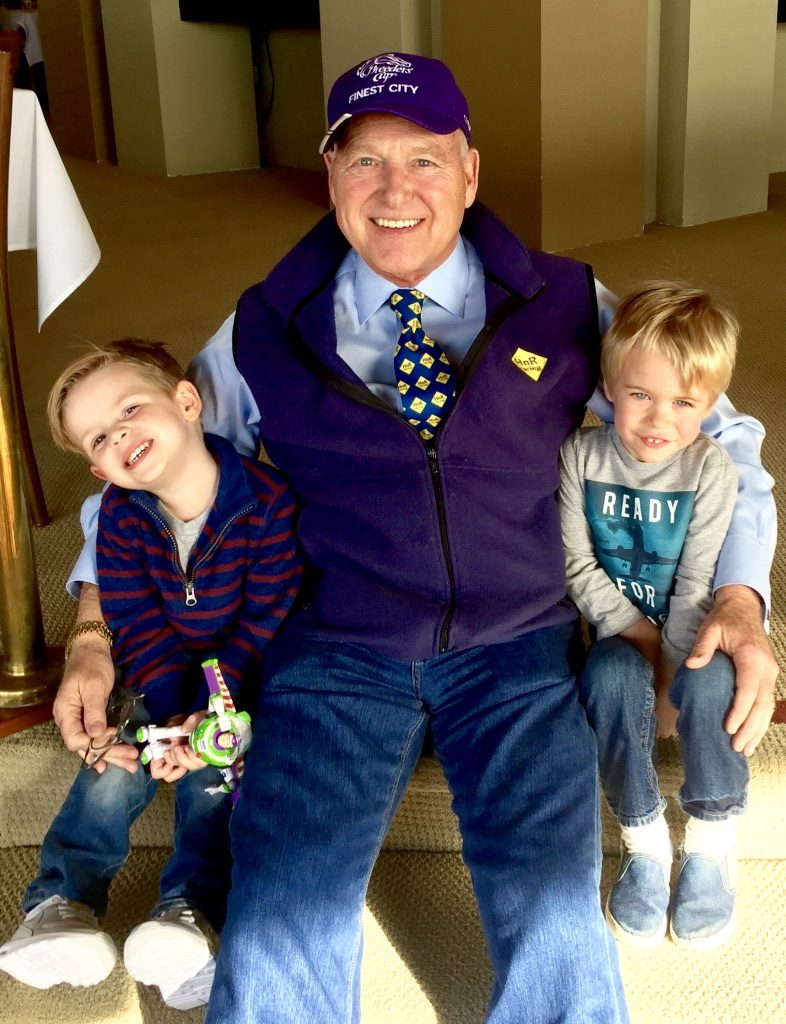

As legendary Kentucky horseman Robert Courtney used to say, that’s how you make money in this business.
Because the Pennsylvania incentive program is going well, Nothhaft said he might increase his mare population to 15, but generally he is concentrating on improving the quality of the band rather than increasing its number.
“Carl and I made a decision not to take the risk of raising them to be yearlings .” Nothhaft said of his early preference for selling weanlings . “At least until now. The yearling market is crazy right now so I’m not unhappy to hold onto them another year because the financial advantage is shifting that way. That hasn’t always been true.” That updated strategy comes in part from the American Pharoah-Kindle weanling colt Nothhaft sold for S400,000 who was pin hooked by Peter O’Callaghan and sold for s2.2 million at last September’s Keeneland yearling auction.
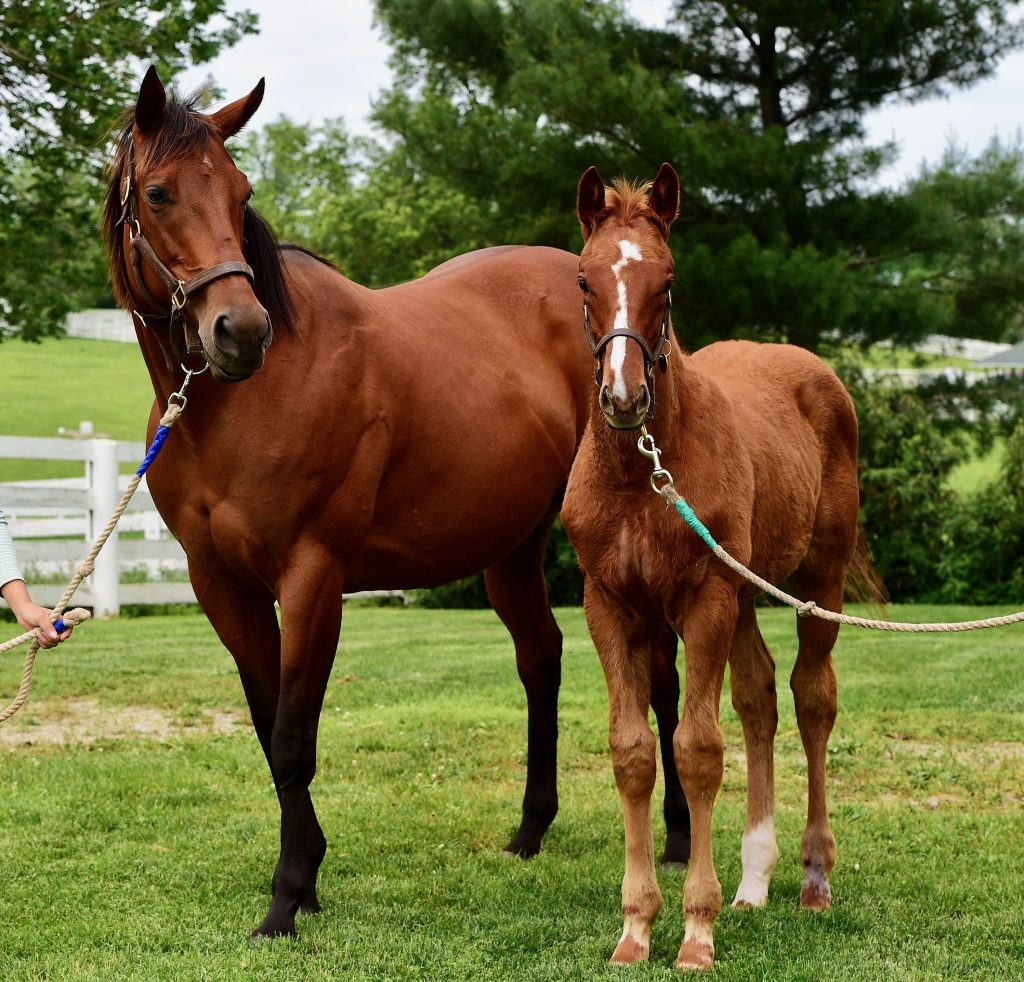
Nothhaft supported McEntee during the latter’s time at Darby Dan Farm and has helped bankroll McEntee’s move to open Ballysax Bloodstock, which now consigns the Nothhaft-breds.
“Carl is all energy and is a hard worker,” said Nothhaft. “In his first year in 2018 he’s had good-quality consignments and gotten good results.
“Hank is an incredibly passionate man who has to have something to d rive him and I’m the same way,” noted McEntee.”He’ll call me at 4 or 5 a.m. his time to talk. He knows only one speed, and that’s 100 mph .”
Nothhaft’s single most notable day in the business came on Nov. 5, 2016. when the Breeders Cup Filly & M are Sprint (G 1) was run at Santa Anita Park. The Nothhaft-owned Living The Life, who had won the Presque lsle Downs Masters in 2014 and 2015 and the All American Stakes (G3) in 2016. was slated to compete against the Nothhaft-hred Finest City, whom the breeder had sold as a weanling in 2012 for $50,000. ‘·My wife and l and other family members were planning to go from our home in Saratoga. Calif. Nothhaft stated. “Then a week before the race, Living the Life came up lame and had to be retired. I was so bummed out I had a knee-jerk reaction to give my tickets away. So we watched from home. I bet heavy on Finest City and when she won. there was an eruption . My phone started going crazy, so there was a lot of recognition of our connection to the horse. But l felt silly watching Gary Mandella accept our trophy.”
In the past, Nothhaft annually compiled what he now calls a “fantasy list ” of stallions for his mares, where he and McEntee would generate a roster of studs that fit his mares although they knew they wouldn’t he able to get to those stallions. Today, it is a different story.
“Now that I have better mares. we know we’re able to get to all the stallions on our list this year.” said Nothhaft. “So we’re not playing fantasy football anymore.” Nothhaft bought back a Pioneer of the Nile-Kindle weanling colt in November 2018 on a final bid of $375,000. He .also kept an American Pharoah-Halljoy yearling filly who RNA’d for $335.000. Those babies are indicative of the quality of stallions to whom he now sends his mares.
“This is a very faddish industry in my opinion,” he stated. “So going to American Pharoah in his first year-if you pick the right first-year stallion it can be a bonanza when you’re selling the progeny. Certainly American Pharoah was a good pick. So we do use some select first-year or young stallions, we call ‘Living the Dream stallions.’ They don’t have anything running yet, or at least won t before (the progeny) sell.
“As far as more proven stallions, we’re not generally going to the heavy hitters such as Tapit, Candy Ride, Into Mischief, and so on. When I was starting out, I bred to Tizbud. a full brother to Tiznow. Now, I love Tiznow, who is one of the less expensive studs I go to today, so that highlights where I started and where I’m at. But I’m also smart enough to know the minute you think you’ve got it all figured out, you’re actually really stupid because the gods are about to come down and chop your knees off. So I keep my feet on the ground.”
Said McEntee, “Hank is unlike most business people who come into the horse industry, where they tend to lose all of their previous business acumen. Hank has maintained the smart decision-making that got him to where he is.”
Nothhaft has worked diligently to try and help ensure that the Pennsylvania incentive program remains on sound footing, although that has proven to be a tricky enterprise in the past. ”Pennsylvania has had a great program for years,” said Nothhaft, “except that the state (government) kept coming up short on funds and taking money away from the breeding program for the general fund. As a breeder, you never knew what was going to be there going forward. What we’ve done is put the program in a trust; while that can still be broken, there is a significant penalty for the state if it decides to take funds away, so we feel more comfortable going forward.
“The number of foals is increasing in the state. There are new sires and brood mares showing up, and the quality of the talent you need is increasing. We know New York-bred and Cal-bred races are tough, but Pennsylvania isn’t a lay-up, either. But it does run between 400 and
500 races a year for state-breds, and if you have a decent horse, you can find a level at which to race and have a good chance of earning some money which is attractive.” ‘ The man on the street- which I consider myself- who doesn’t have 200 horses can realistically breed Pennsylvania-breds and sell or race them with the anticipation of a reasonable financial outcome. That’s the world I thought I was getting into way back at the start.”
A dose of naivete represent standard equipment for those seeking entrance to the Thoroughbred industry as a business proposition . And the addition of successful business people such as Hank Nothhaft to its ranks swells the legitimacy as well as the feasibility of this world of horses. He has embraced a challenge far too puzzling for most; entered on the ground floor and built a sturdy operation upward despite knowing nothing about its workings when he started. That horses can rekindle this sort of passion in a person of substance such as Nothhaft is a huge positive.
“l have been retired from the tech world for three or four years now, and I thank God every morning that l got involved in the horse business because it so satisfying,” he said. “It is extremely difficult, so when things do go right, the satisfaction and the adrenaline and the good feeling you get is so significant that it’s worth all the effort. “For a small guy like me, you have to work really hard to have something good going on, and when it does, it keeps you in a good mood for a while and you really have to inhale the happy fumes and the success . You have to ride over what I call th e Valley of Despair to keep your self going and motivated if you’re passionate about it.”■


